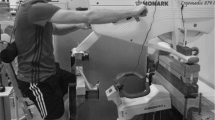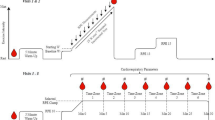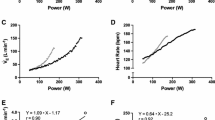Abstract
Purpose
Rating of perceived exertion (RPE) is a reliable method of assessing exercise intensity during isolated arm and leg cycling. The aim of this study was to assess the validity and reproducibility of perceptually regulated exercise responses during combined arm + leg cycling.
Methods
Twelve males (age; 24.6 ± 5.3 years, height; 1.81 ± 0.7 m, mass; 83.1 ± 8.4 kg) initially undertook incremental exercise tests to volitional exhaustion for arm cycling (133 ± 14 W) and leg cycling (253 ± 32 W). On three subsequent occasions, participants undertook combined arm + leg cycling trials using two modified Monark ergometers involving three bouts of exercise at RPE 9, 13 and 17, in that order. Heart rate (HR), oxygen uptake (\(\dot{V}{\text{O}}_{{2}}\)) and pulmonary ventilation (\(\dot{V}_{{\text{E}}}\)) were recorded continuously.
Results
No significant differences were observed for HR (P = 0.086), \(\dot{V}{\text{O}}_{{2}}\) (P = 0.525) and \(\dot{V}_{{\text{E}}}\) (P = 0.899) between trials, whilst significant differences were observed between each level of RPE (all P < 0.001). For % peak \(\dot{V}{\text{O}}_{{2}}\), the ICC increased with successive trials for all RPE levels. For % maximal HR the ICC generally decreased with successive trials.
Conclusion
RPE can be used as a reliable frame of reference for the production of exercise intensity during combined arm + leg cycling without any formal familiarisation. Since combined arm + leg cycling elicits a greater energy expenditure than arm or leg work alone, this novel mode of non-weight bearing exercise might prove effective for aerobic conditioning and weight control.




Similar content being viewed by others
Change history
06 October 2020
The original version of this article unfortunately contained a mistake.
Abbreviations
- ANOVA:
-
Analysis of variance
- CV:
-
Coefficient of variation
- HR:
-
Heart rate
- HRmax :
-
Maximal heart rate
- ICC:
-
Intraclass correlation coefficient
- LoA:
-
Limits of agreement
- PO:
-
Power output
- PPO:
-
Peak minute power
- RER:
-
Respiratory exchange ratio
- RPE:
-
Rating of perceived exertion
- RPEA :
-
Ratings of perceived exertion (arms)
- RPEL :
-
Ratings of perceived exertion (legs)
- RPEC :
-
Ratings of perceived exertion (central)
- RPEP :
-
Ratings of perceived exertion (peripheral)
- V̇ E :
-
Pulmonary ventilation
- V̇ Epeak :
-
Peak pulmonary ventilation
- V̇O2 :
-
Oxygen uptake
- V̇O2peak :
-
Peak oxygen uptake
References
Atkinson G, Nevill AM (1998) Statistical methods for assessing measurement error (reliability) in variables relevant to sports medicine. Sport Med. https://doi.org/10.2165/00007256-199826040-00002
Bergh U, Kanstrup IL, Ekblom B (1976) Maximal oxygen uptake during exercise with various combinations of arm and leg work. J Appl Physiol. https://doi.org/10.1152/jappl.1976.41.2.191
Bland JM, Altman D (1986) Statistical methods for assessing agreement between two methods of clinical measurement. Lancet 327(8476):307–310
Borg G (1970) Perceived exertion as an indicator of somatic stress. Scand J Rehabil Med 2:92–98
Borg G (1982) Psychophysical bases of perceived exertion. Med Sci Sports Exerc 14(5):377–381
Borg G, Hassmén P, Lagerström M (1987) Perceived exertion related to heart rate and blood lactate during arm and leg exercise. Eur J Appl Physiol Occup Physiol. https://doi.org/10.1007/BF00424810
Buckley JP, Eston RG, Sim J (2000) Ratings of perceived exertion in braille: validity and reliabity in production mode. Br J Sports Med. https://doi.org/10.1136/bjsm.34.4.297
Collett ME, Liljestrand G (1924) The minute volume of the heart in man during some different types of exercise 1. Skandinavisches Archiv Für Physiologie 45(1):29–42
Dunbar CC, Goris C, Michielli DW, Kalinski MI (1994) Accuracy and reproducibility of an exercise prescription based on ratings of perceived exertion for treadmill and cycle ergometer exercise. Percept Mot Skills. https://doi.org/10.2466/pms.1994.78.3c.1335
Dunbar CC, Robertson RJ, Baun R et al (1992) The validity of regulating exercise intensity by ratings of perceived exertion. Med Sci Sports Exerc. https://doi.org/10.1249/00005768-199201000-00016
Ekblom B, Golobarg AN (1971) The Influence of physical training and other factors on the subjective rating of perceived exertion. Acta Physiol Scand. https://doi.org/10.1111/j.1748-1716.1971.tb05093.x
Eston RG, Brodie DA (1986) Responses to arm and leg ergometry. Br J Sports Med. https://doi.org/10.1136/bjsm.20.1.4
Eston RG, Williams JG (1988) Reliability of ratings of perceived effort regulation of exercise intensity. Br J Sports Med. https://doi.org/10.1136/bjsm.22.4.153
Eston RG, Faulkner JA, Mason EA, Parfitt G (2006) The validity of predicting maximal oxygen uptake from perceptually regulated graded exercise tests of different durations. Eur J Appl Physiol. https://doi.org/10.1007/s00421-006-0213-x
Eston RG, Lamb KL, Parfitt G, King N (2005) The validity of predicting maximal oxygen uptake from a perceptually-regulated graded exercise test. Eur J Appl Physiol. https://doi.org/10.1007/s00421-005-1327-2
Eston R, Lambrick D, Sheppard K, Parfitt G (2008) Prediction of maximal oxygen uptake in sedentary males from a perceptually regulated, sub-maximal graded exercise test. J Sports Sci. https://doi.org/10.1080/02640410701371364
Faulkner J, Parfitt G, Eston R (2007) Prediction of maximal oxygen uptake from the ratings of perceived exertion and heart rate during a perceptually-regulated sub-maximal exercise test in active and sedentary participants. Eur J Appl Physiol. https://doi.org/10.1007/s00421-007-0508-6
Gleser MA, Hoestman DH, Mello RP (1974) The effect on Vo2 max of adding arm work to maximal leg work. Med Sci Sports Exerc. https://doi.org/10.1249/00005768-197400620-00018
Gutin B, Ang KE, Torrey K (1988) Cardiorespiratory and subjective responses to incremental and constant load ergometry with arms and legs. Arch Phys Med Rehabil. https://doi.org/10.1097/00008483-198810000-00011
Hartshorn JEO, Lamb KL (2004) The reproducibility of perceptually regulated exercise responses during short-term cycle ergometry. Int J Sports Med. https://doi.org/10.1055/s-2004-815840
Hill MW, Goss-Sampson M, Duncan MJ, Price MJ (2014) The effects of maximal and submaximal arm crank ergometry and cycle ergometry on postural sway. Eur J Sport Sci. https://doi.org/10.1080/17461391.2014.905985
Hill M, Talbot C, Puddiford M, Price M (2018) Cardiorespiratory and perceptual responses to self-regulated and imposed submaximal arm–leg ergometry. Eur J Appl Physiol. https://doi.org/10.1007/s00421-018-3838-7
Hill M, Talbot C, Price M (2016) Predicted maximal heart rate for upper body exercise testing. Clin Physiol Funct Imaging. https://doi.org/10.1111/cpf.12201
Hoffman MD, Kassay KM, Zeni AI, Clifford PS (1996) Does the amount of exercising muscle alter the aerobic demand of dynamic exercise? Eur J Appl Physiol Occup Physiol. https://doi.org/10.1007/BF02376770
Kang J, Chaloupka EC, Mastrangelo MA et al (1998) Regulating exercise intensity using ratings of perceived exertion during arm and leg ergometry. Eur J Appl Physiol Occup Physiol. https://doi.org/10.1007/s004210050414
Kang J, Robertson RJ, Goss FL et al (1997) Metabolic efficiency during arm and leg exercise at the same relative intensities. Med Sci Sports Exerc. https://doi.org/10.1097/00005768-199703000-00013
Lamb KL, Eston RG, Corns D (1999) Reliability of ratings of perceived exertion during progressive treadmill exercise. Br J Sports Med. https://doi.org/10.1136/bjsm.33.5.336
Marriott HE (1996) The use of ratings of perceived exertion for regulating exercise levels in rowing ergometry. Eur J Appl Physiol Occup Physiol. https://doi.org/10.1007/BF00838650
Midgley AW, McNaughton LR, Polman R, Marchant D (2007) Criteria for determination of maximal oxygen uptake. Sports Med. https://doi.org/10.2165/00007256-200737120-00002
Nagle FJ, Richie JP, Giese MD (1984) Vo2max responses in separate and combined arm and leg air-braked ergometer exercise. Med Sci Sports Exerc. https://doi.org/10.1249/00005768-198412000-00007
Pandolf KB, Billings DS, Drolet LL et al (1984) Differentiated ratings of perceived exertion and various physiological responses during prolonged upper and lower body exercise. Eur J Appl Physiol Occup Physiol. https://doi.org/10.1007/BF00964681
Robertson RJ (1982) Central signals of perceived exertion during dynamic exercise. Med Sci Sports Exerc 14:390–396
Sawka MN (1986) Physiology of upper body exercise. Exerc Sport Sci Rev. https://doi.org/10.1249/00003677-198600140-00009
Secher NH, Ruberg Larsen N, Binkhorst RA, Bonde Petersen F (1974) Maximal oxygen uptake during arm cranking and combined arm plus leg exercise. J Appl Physiol. https://doi.org/10.1152/jappl.1974.36.5.515
Skinner JS, Hutsler R, Bergsteinova V, Buskirk ER (1973) Perception of effort during different types of exercise and under different environmental conditions. Med Sci Sports. https://doi.org/10.1249/00005768-197300520-00021
Stenberg J, Astrand PO, Ekblom B et al (1967) Hemodynamic response to work with different muscle groups, sitting and supine. J Appl Physiol. https://doi.org/10.1152/jappl.1967.22.1.61
Travlos AK, Marisi DQ (1996) Perceived exertion during physical exercise among individuals high and low in fitness. Percept Mot Skills. https://doi.org/10.2466/pms.1996.82.2.419
Ueda T, Kurokawa T (1995) Relationships between perceived exertion and physiological variables during swimming. Int J Sports Med. https://doi.org/10.1055/s-2007-973025
Zinner C, Sperlich B, Born DP, Michels G (2017) Effects of combined high intensity arm and leg training on performance and cardio-respiratory measures. J Sports Med Phys Fitness. https://doi.org/10.23736/S0022-4707.16.06539-7
Author information
Authors and Affiliations
Contributions
MH conceived and designed research. MH, MP2 and CT conducted experiments. MH performed the analyses and wrote the manuscript. MH, CT, MP2 and MP1 revised the manuscript. All authors read and approved the final manuscript.
Corresponding author
Ethics declarations
Conflict of interest
The authors declare that they have no conflict of interest.
Additional information
Communicated by Michael Lindinger.
Publisher's Note
Springer Nature remains neutral with regard to jurisdictional claims in published maps and institutional affiliations.
Rights and permissions
About this article
Cite this article
Hill, M., Puddiford, M., Talbot, C. et al. The validity and reproducibility of perceptually regulated exercise responses during combined arm + leg cycling. Eur J Appl Physiol 120, 2203–2212 (2020). https://doi.org/10.1007/s00421-020-04444-z
Received:
Accepted:
Published:
Issue Date:
DOI: https://doi.org/10.1007/s00421-020-04444-z




